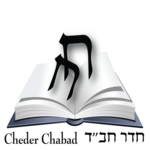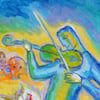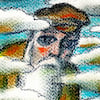A form of the word darash, meaning “inquire” or “expound,” midrash is the rabbinic endeavor of mining the text of Tanach (the Hebrew Bible) to extract nuggets of hidden wisdom from its subterranean layers. This distinguishes midrash from peshat, which seeks to determine the literal meaning of the text.
These midrashic texts can be divided into:
- Midrash Aggadah—homiletic teachings, either extending the biblical narrative or providing parables with moral lessons.
- Midrash Halachah—deriving further details of Jewish law from the biblical text.
Read: Stories of the Midrash
Is Midrash the Same as Talmud?
The Midrash and Talmud are different texts, but there are many links. Produced by the same rabbis, and based on the same corpus of tradition and scholarship, there is often significant overlap between the two, and the same teachings may appear (with certain variances) in both.
There is, however, a major distinction. The Midrash primarily begins with the biblical text and then teases out the lessons and laws. The Talmud, conversely, is (loosely) organized by subject, and the lessons are discussed when deemed thematically appropriate.
Is Midrash Meant To Be Taken Literally?
The purpose of midrash is not to explain the simple meaning of the text, nor to determine historical fact. Rather, it is to reveal hidden meanings implied in the text.
As well, the text of Tanach often includes anomalies that can only be understood as allusions to some deeper meaning. Rashi, the leading peshat commentator on Tanach, demonstrates this to be the case with the very first verse of the Torah and in many other instances.
Sometimes, the best way to express the deeper, hidden meaning is through a tale or metaphor, and a Midrash Aggadah may speak in fantastic terms to do so. To paraphrase R. Menachem Azaria Da Fano (16th-century Italy), every midrash is a true description of reality, albeit not necessarily on the material plane.
Indeed, Jewish children have been raised on and inspired by stories of the Midrash for millennia. As they grow up, with the aid of their teachers, these children will learn to find deeper and deeper meaning in these stories, according to their level of maturity and understanding.
Some Major Midrashic Works
Midrash Halachah
The first book of the Torah has very little in the way of laws. Thus, the major Midrash Halachah works are companions for the final four books only.
Mechilta This primarily refers to a running commentary on the Book of Exodus of produced by the academy of Rabbi Yishmael. The word mechilta means a vessel with which to measure, appropriate as the Midrash carefully weighs and considers the Scripture through the hermeneutical principles.1
Sifra A companion to the Book of Leviticus, also known as Torat Kohanim, “the priestly teaching.” It is associated with the yeshivahs of Rabbi Yehuda and Rav respectively. The word Sifra literally means “the book.”
Sifrei Literally “books,” this refers to the (unrelated) companions to Numbers and Deuteronomy.
Sifrei Zuta An early commentary on the Book of Numbers that was mostly lost during the Middle Ages. Sections have been preserved in Midrash Hagadol and Yalkut Shimoni. Additional sections were also discovered in the Cairo Geniza.
Midrash Aggadah
Midrash Rabbah: When someone says “the Midrash” without qualifying, chances are they are referring to Midrash Rabbah (“Great Midrash”), which contains a volume for each of the Five Books of Moses, as well as one on each of the five megillahs.
Tanchuma: A collection associated with the Talmudic sage Rabbi Tanchuma bar Abba, about whom little is known beyond his copious aggadic output. Although not everything contained in Midrash Tanchuma is ascribed to him, they are all of similar style. This Midrash is often quoted by Rashi and many others.
Midrash Hagadol: A collection of both aggadic and halachic midrash compiled in Yemen by Rabbi David ben Amram Adani in the 14th century. It is an eclectic work compiled from a wide variety of Tannaic, Talmudic and post-Talmudic sources. Midrash Hagadol has been the source for many sections of Midrash that have otherwise disappeared.
Pesikta D’Rav Kahana: Covers the Torah readings and haftarahs for the holidays and other special times of the year. Possibly sourced to Rav Kahana who was a student of Rav.2 Even though this is widely quoted by the Rishonim, it was printed from manuscript for the first time in the 19th century.
Pesikta Rabbati: Similar to Pesikta D’Rav Kahana, with some overlapping content, it is also organized according to the Torah readings. It is called Rabbati (large) as a way to differentiate it from the earlier Pesikta D’Rav Kahana.
Yalkut Shimoni: A “late Midrash” from the era of the Rishonim, the Yalkut Shimoni (“Simon’s Collection”) aggregates from earlier Midrashic sources and arranges them in order of the 24 books of the Tanach.
Tana D’vei Eliyahu: According to tradition, this Midrash was taught by Elijah the Prophet to the Talmudic sage Rav Anan.3 It consists of two sections Eliyahu Rabbah and Eliyahu Zuta. Unlike other midrashic material, Tana D’vei Eliyahu is not organized according to biblical verses. Instead, it flows from topic to topic, beginning with the Creation of the world and traversing Jewish History, including the future Messianic times.
Pirkei D’Rabbe Eliezer: Attributed to Rabbi Eliezer ben Hurcanus, it is primarily a commentary on Genesis and Exodus, focused on expounding on the Creation narrative and the Exodus from Egypt.
Midrash Shmuel: A commentary on the Book of Samuel, it is the only Midrash to be written on the Prophets. It was compiled by an unknown individual sometime after the composition of the Talmud and incorporates a vast array of Rabbinic teaching.
Midrash Socher Tov (Midrash Tehillim): This “late Midrash” was originally only on chapters 1–118 of Psalms. In later additions, material was added for the remainder of the chapters until 150.
Seder Olam: This important work sets out the chronology from the Creation of the World until the era of Alexander the Great, establishing the traditional framework through which Jewish history is organized and the calendar is calculated. See: A Timeline of Jewish History
Lekach Tov (Pesikta Zutarta): Written in the 11th century by Rabbi Tuvia ben Eliezer, it is a commentary on the Five Books of Moses and the five megillahs. It was sometimes confused with Pesikta Rabbati.
Note that these are just some works among many, and several midrashic works have survived in multiple forms, at times so different that it is unclear whether they are indeed two versions of the same book or entirely different works.







Start a Discussion